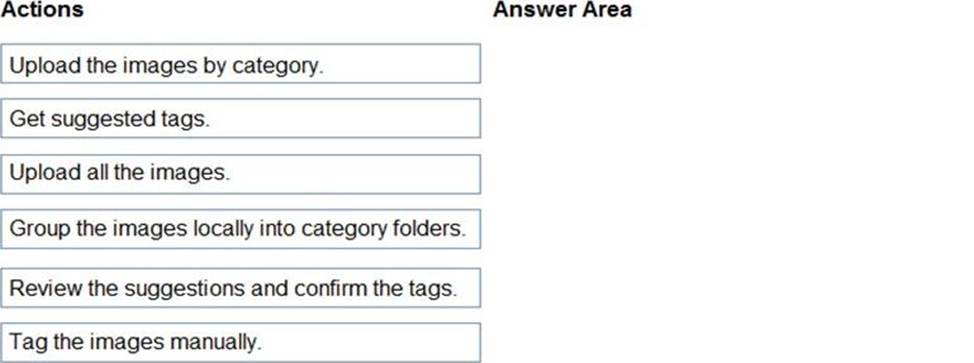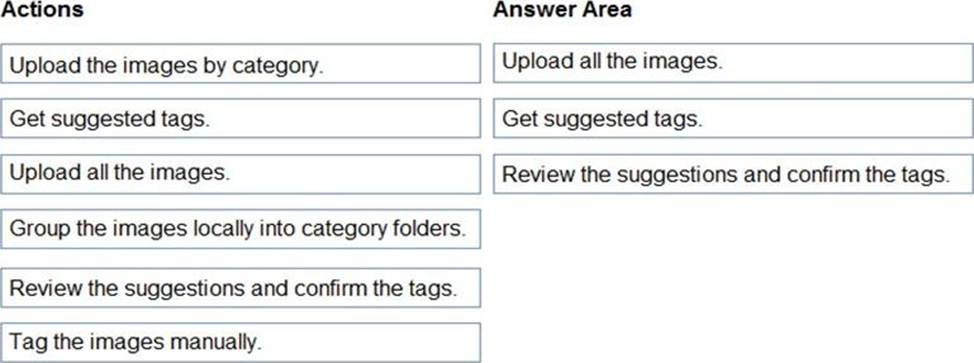Practice Free AI-102 Exam Online Questions
You create a bot by using the Microsoft Bot Framework SDK.
You need to configure the bot to respond to events by using custom text responses.
What should you use?
- A . an adaptive card
- B . an activity handler
- C . a dialog
- D . a skill
HOTSPOT
You have an Azure subscription that contains an Azure OpenA1 resource.
You configure a model that has the following settings:
• Temperature: 1
• Top probabilities: 0.5
• Max response tokens: 100
You ask the model a question and receive the following response.

For each of the following statements, select Yes if the statement is true. Otherwise, select No. NOTE: Each correct selection is worth point.


DRAG DROP
You build a bot by using the Microsoft Bot Framework SDK.
You need to test the bot interactively on a local machine.
Which three actions should you perform in sequence? To answer, move the appropriate actions from the list of actions to the answer area and arrange them in the correct order. NOTE: More than one order of answer choices is correct. You will receive credit for any of the correct orders you select.


HOTSPOT
You are building a chatbot for a Microsoft Teams channel by using the Microsoft Bot Framework SDK.
The chatbot will use the following code.

For each of the following statements, select Yes if the statement is true. Otherwise, select No. NOTE: Each correct selection is worth one point.


Explanation:
Box 1: Yes
The ActivityHandler.OnMembersAddedAsync method overrides this in a derived class to provide logic for when members other than the bot join the conversation, such as your bot’s welcome logic.
Box 2: Yes
membersAdded is a list of all the members added to the conversation, as described by the conversation update activity.
Box 3: No
Reference: https://docs.microsoft.com/en-us/dotnet/api/microsoft.bot.builder.activityhandler.onmembersaddedasync?view=botbuilder-dotnet-stable
DRAG DROP
You have a question answering project in Azure Cognitive Service for Language.
You need to move the project to a Language service instance in a different Azure region.
Which three actions should you perform in sequence? To answer, move the appropriate actions from the list of actions to the answer area and arrange them in the correct order.


HOTSPOT
You have a chatbot that uses the Azure Al Language custom question answering service.
You need to test the chatbot. The solution must ensure that the chatbot responds only when an answer has a confidence score of at least 95 percent.
How should you complete the cURL statement? To answer, select the appropriate options in the answer area. NOTE: Each correct selection is worth one point.


You need to create a visualization of running sales totals per quarter as shown in the following exhibit.

What should you create in Cower Bl Desktop;1
- A . a waterfall chart
- B . a ribbon chart
- C . a bar chart
- D . a decomposition tree
Note: This question is part of a series of questions that present the same scenario. Each question in the series contains a unique solution that might meet the stated goals. Some question sets might have more than one correct solution, while others might not have a correct solution.
After you answer a question in this section, you will NOT be able to return to it. As a result, these questions will not appear in the review screen.
You develop an application to identify species of flowers by training a Custom Vision model. You receive images of new flower species.
You need to add the new images to the classifier.
Solution: You add the new images, and then use the Smart Labeler tool.
Does this meet the goal?
- A . Yes
- B . No
B
Explanation:
The model need to be extended and retrained.
Note: Smart Labeler to generate suggested tags for images. This lets you label a large number of images more quickly when training a Custom Vision model.
You ace building an internet-based training solution. The solution requires that a user’s camera and microphone remain enabled.
You need to monitor a video stream of the user and detect when the user asks an instructor a question. The solution must minimize development effort.
What should you include in the solution?
- A . object detection in Azure Al Custom Vision
- B . the Face service in Azure Al Vision
- C . language detection in Azure Al Language Service
- D . speech-to-text in the Azure Al Speech service
DRAG DROP
You train a Custom Vision model used in a mobile app.
You receive 1,000 new images that do not have any associated data.
You need to use the images to retrain the model. The solution must minimize how long it takes to retrain the model.
Which three actions should you perform in the Custom Vision portal? To answer, move the appropriate actions from the list of actions to the answer area and arrange them in the correct order.


Explanation:
